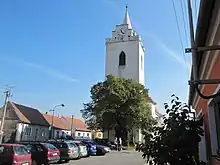Dolní Věstonice
Dolní Věstonice (German: Unterwisternitz) is a municipality and village in Břeclav District in the South Moravian Region of the Czech Republic. It has about 300 inhabitants. It is known for the eponymous archaeological site.
Dolní Věstonice | |
|---|---|
 View of Dolní Věstonice from Děvín | |
 Flag  Coat of arms | |
 Dolní Věstonice Location in the Czech Republic | |
| Coordinates: 48°53′14″N 16°38′38″E | |
| Country | |
| Region | South Moravian |
| District | Břeclav |
| First mentioned | 1312 |
| Area | |
| • Total | 8.82 km2 (3.41 sq mi) |
| Elevation | 174 m (571 ft) |
| Population (2023-01-01)[1] | |
| • Total | 293 |
| • Density | 33/km2 (86/sq mi) |
| Time zone | UTC+1 (CET) |
| • Summer (DST) | UTC+2 (CEST) |
| Postal code | 691 29 |
| Website | www |
Geography
Dolní Věstonice is located about 22 kilometres (14 mi) northwest of Břeclav and 33 km (21 mi) south of Brno. It lies on the border between the Mikulov Highlands and Dyje–Svratka Valley. The highest point is at 316 m (1,037 ft) above sea level. The village is situated on the shore of the Nové Mlýny reservoirs. The municipality is partly located in the Pálava Protected Landscape Area. The area of the reservoir is protected as the Věstonice Reservoir Nature Reserve.
History

Prehistoric times
Dolní Věstonice is known for the Dolní Věstonice archaeological site. Approximately 25,000 years ago, during the Upper Paleolithic period of the Stone Age, a small settlement of mammoth hunters consisting of huts built with rocks and mammoth bones was founded on the site of what is now Dolní Věstonice. This is the oldest permanent human settlement that has ever been found.[2] Numerous other archaeological discoveries point to extensive human habitation of the area in prehistoric times. The archaeological site is also known for the finding of the Venus of Dolní Věstonice, one of the most important archaeological discoveries in Europe and one of the oldest and most famous art in the world.[3]
9th–20th century
During the Great Moravia period, which lasted between the 9th and 10th centuries, a small Slavic gord was built here. The gord protected a ford on an important trade route.[4]
The first written mention of Věstonice is from 1312. During the 13th century the place became inhabited by German colonists. In 1460, the village was promoted to a market town by King George of Poděbrady. From the beginning of the 16th century until their expulsion in 1622, the Anabaptists settled here. They were famous for their high level of education and the establishment of wine cellars, which have survived to this day.[4]
In 1938, it was annexed by Nazi Germany and administered as part of Reichsgau Niederdonau. The German speaking population was expelled in 1945 according to the Beneš decrees and replaced by Czech settlers.
Demographics
|
|
| ||||||||||||||||||||||||||||||||||||||||||||||||||||||
| Source: Censuses[5][6] | ||||||||||||||||||||||||||||||||||||||||||||||||||||||||
Economy
Dolní Věstonice is known for viticulture. The municipality lies in the Mikulovská wine subregion.
Sights

The main landmark of Dolní Věstonice is the Church of Saint Michael the Archangel. It is a Baroque building with a Gothic core and Renaissance tower.[7]
Tourist attractions follow the archaeological glory of the municipality. The archaeological site includes an outdoor exhibition. An educational archeological path leads from Dolní Věstonice to neighbouring Pavlov.[8]
Remains of the gord rampart and floor plan of the church, which stood here until the early 13th century, are preserved.[4]
References
- "Population of Municipalities – 1 January 2023". Czech Statistical Office. 23 May 2023.
- Stuart, Gene S. (1979). "Ice Age Hunters: Artists in Hidden Cages". Mysteries of the Ancient World. National Geographic Society. p. 19.
- "Prehistoric settlement near Dolní Věstonice and Pavlov". CzechTourism. Retrieved 29 November 2021.
- "O obci Dolní Věstonice" (in Czech). Obec Dolní Věstonice. Retrieved 29 November 2021.
- "Historický lexikon obcí České republiky 1869–2011 – Okres Břeclav" (in Czech). Czech Statistical Office. 21 December 2015. pp. 1–2.
- "Population Census 2021: Population by sex". Public Database. Czech Statistical Office. 27 March 2021.
- "Kostel sv. Michala archanděla" (in Czech). National Heritage Institute. Retrieved 21 June 2023.
- "Archeostezka Pavlov – Naučná stezka z archeoparku v Pavlově do Dolních Věstonic" (in Czech). CzechTourism. Retrieved 21 June 2023.